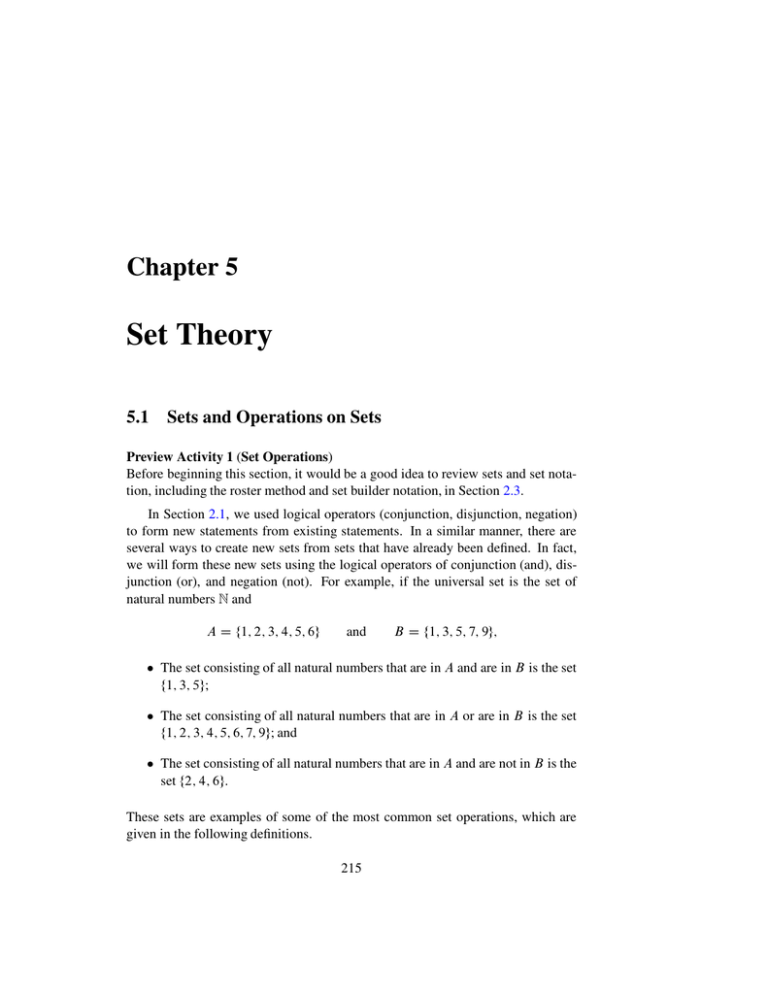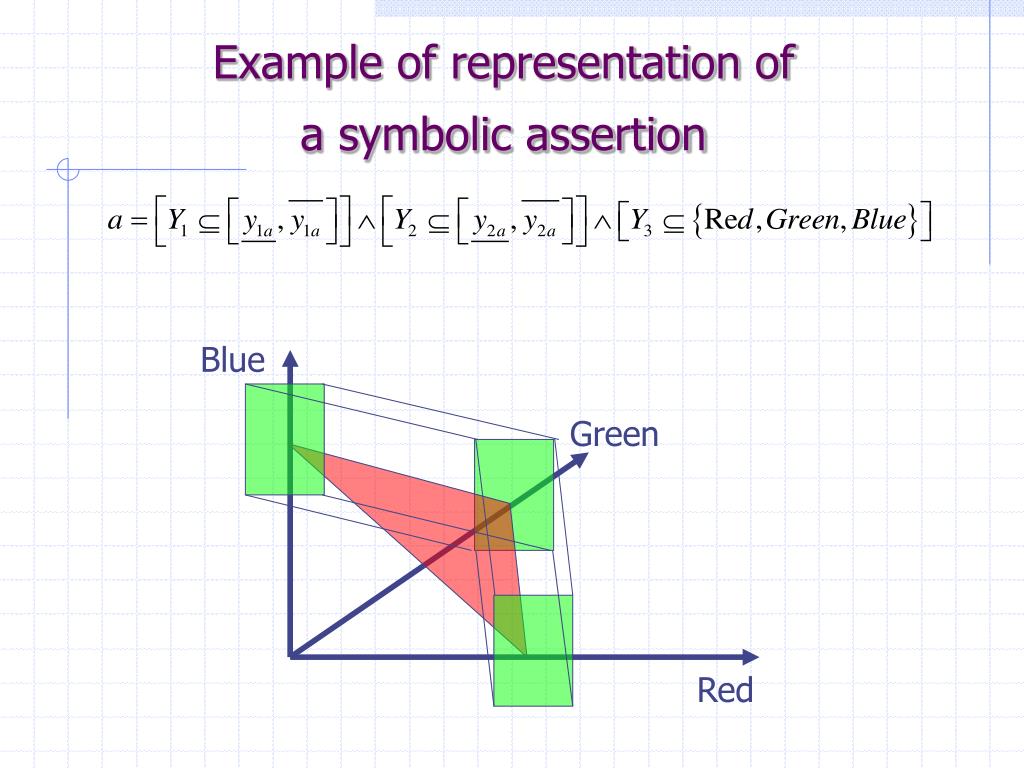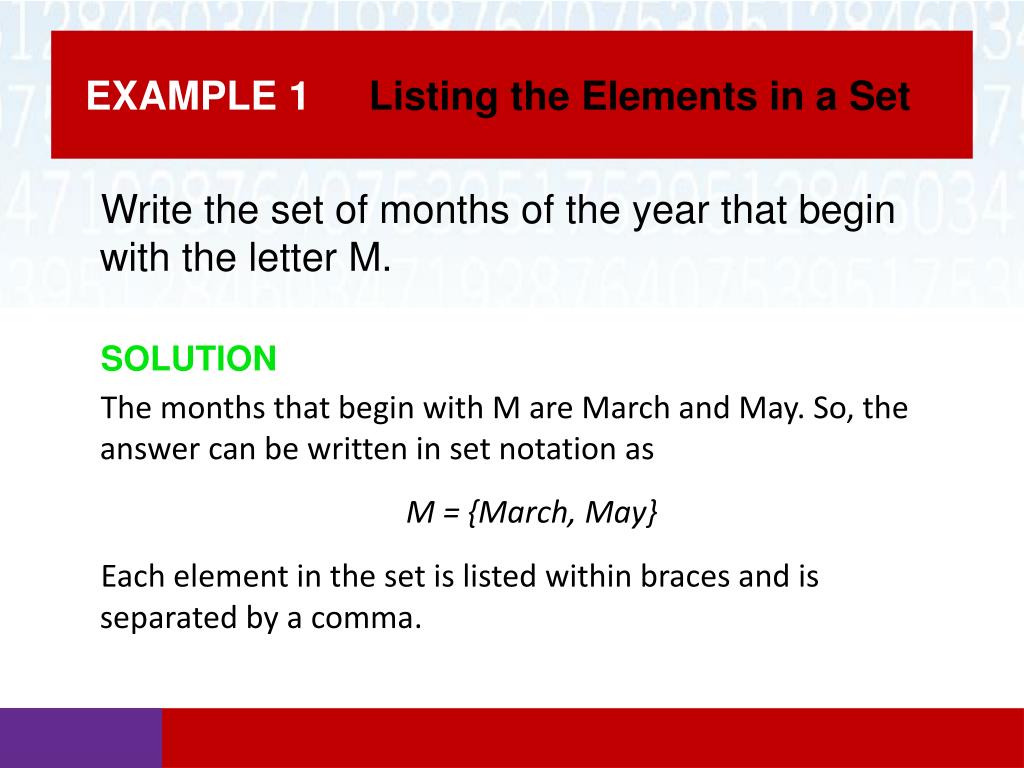For example, the number 5 is an integer, and so it is appropriate to write \(5 \in \mathbb\). It is not appropriate, however, to write \(5 \subseteq \mathbb\) since 5 is not a set. It is important to distinguish between 5 and . The difference is that 5 is an integer and is a set consisting of one element. Consequently, it is appropriate to write \(\ \subseteq \mathbb\), but it is not appropriate to write \(\ \in \mathbb\). The distinction between these two symbols is important when we discuss what is called the power set of a given set.
The set can be defined by listing all its elements, separated by commas and enclosed within braces. In Preview Activity \(\PageIndex\), we worked with verbal and symbolic definitions of set operations. However, it is also helpful to have a visual representation of sets. Venn diagrams are used to represent sets by circles drawn inside a rectangle. For example, Figure \(\PageIndex\) is a Venn diagram showing two sets. You know that the set of natural numbers N, the set of integers Z are subsets of the set of real numbers R.
Thus, for this discussion R is a universal set. For example, the set includes all the natural numbers from 1 to 100. The cardinal number of a set is the number of elements in the set. For a set A the symbol for the cardinality is n, which is read as "n of A."
The roster method is defined as a way to show the elements of a set by listing the elements inside of brackets. An example of the roster method is to write the set of numbers from 1 to 10 as . An example of the roster method is to write the seasons as . Now, let's convert the sets above from the verbal description method to roster notation. Ans.2 Finite set and infinite sets, equal set and equivalent sets, a null set, singleton set, universal set and subset are few types of set.
Use set builder notation or the roster method to specify the set of integers that are the sum of eight consecutive integers. Use set builder notation or the roster method to specify the set of integers that are the sum of four consecutive integers. The definitions of these numbers may be somewhat elaborate. Let's look at some examples of set-builder notation. The elements in a set can be represented in a number of ways, some of which are more useful for mathematical treatment and others for general understanding. These different methods of describing a set are called set notations.
The objects used to form a set are called its element or its members. Generally, the elements of a set are written inside a pair of curly braces and are represented by commas. The name of the set is always written in capital letter.
Here 'A' is the name of the set whose elements are v, w, x, y, z. The set can be defined by describing the elements using mathematical statements. Set is a well-defined collection of objects or elements. A Set is represented using the Capital Letters and the elements are enclosed within curly braces . Refer to the entire article to know about Representation of Set in three different ways such as Statement Form, Set Builder Form, Roster Form.
For a Complete idea on this refer to theSet Theoryand clear all your queries. Check out Solved Examples for all three forms explained step by step. The object is a set is called its element or member.
We denote sets by capital letters A, B, C, etc. The elements of a set are represented by small letters a, b, c, x, y, z etc. If x is an element of a set A, we write \(\in\) A, and read as 'belongs to A'. If x is not an element of a set A, we write x \(\notin\) A and read as 'x does not belong to A'.
1 Learning Objectives for Section 7.2 Sets After today's lesson, you should be able to Identify and use set properties and set notation. Set is defined as a well-defined collection of objects. Different types of sets are classified according to the number of elements they have. Basically, sets are the collection of distinct elements of the same type.
For example, a basket of apples, a tea set, a set of real numbers, natural numbers, etc. A set is called finite if it has no elements, or has cardinality that is a natural number. A set that is not finite is called an infinite set.
Let \(A\) and \(B\) be subsets of a universal set \(U\). For each of the following, draw a Venn diagram for two sets and shade the region that represent the specified set. In addition, describe the set using set builder notation. Before beginning this section, it would be a good idea to review sets and set notation, including the roster method and set builder notation, in Section 2.3. One can describe a set by specifying a rule or a verbal description. For example, one can say "let \(A\) be the set of all odd integers".
Then \(A\) is a set and its elements are all the odd integers. In this, a rule, or the formula or the statement is written within the pair of brackets so that the set is well defined. In the set builder form, all the elements of the set, must possess a single property to become the member of that set. Now read a set in set-builder notation, formulate a verbal description and give the set in roster form.
In mathematics, we deal with different collections of numbers, symbols, or even equations. We give these kinds of collections a special name in mathematics; we call them sets. We may wish to describe these collections as a way of understanding their properties or discussing their relationships with each other. Roster notation-it done by listing all the elements separated by comma or braces. Verbal description method- it is a method of describing a set in a word. Write each set in the indicated form.If you need to use "... " to indicate a pattern, make sure to list at least four elements of the set.
As you answer below, remember that the natural numbers are just the counting numbers. This means that 0 is not a natural number, and negative numbers are not natural numbers either. Use the roster method to write the given set. You may need to consult a reference, such as the Internet or an encyclopedia. (Enter EMPTY for the empty set.) The set of negative integers greater than −6.
MathAlgebraQ&A LibraryUse the roster method to write the given set. The total number of unique elements in the set is called the cardinality of the set. The cardinality of the countably infinite set is countably infinite.
A set in which the process of counting of elements comes to an end is called a finite set. A set which is not finite is called an infinite set. Mrs. Glosser usedset-builder notation, a shorthand used to write sets, often sets with aninfinitenumber of elements. A Universal Set is the set of all elements under consideration, denoted by capital U.
All other sets are subsets of the universal set. These two properties are sufficient to describe each element of the set. This method involves specifying a rule or condition which can be used to decide whether an object can belong to the set. Use the roster method to list all of the elements of each of the following sets. We need to use set builder notation for the set \(\mathbb\) of all rational numbers, which consists of quotients of integers. We can use set notation to specify and help describe our standard number systems.
The starting point is the set of natural numbers, for which we use the roster method. Let \(A\) and \(B\) be two sets contained in some universal set \(U\). The set \(A\) is a proper subset of \(B\) provided that \(A \subseteq B\) and \(A \ne B\). When \(A\) is a proper subset of \(B\), we write \(A \subset B\). Sets are arguably the most fundamental objects in modern mathematics.
Familiarity with set notation is a prerequisite to reading post-secondary mathematics. What follows is a brief summary of key definitions and concepts related to sets required in this course. We refer to this method as the roster notation because a roster is a list of elements in the set. This method is also called the tabulation method.
When using this method, we list the elements of the set in a row between curly braces. If the elements of a set have a common property then they can be defined by describing the property. A set which contains infinite number of elements is called an infinite set. A grouping of the members within a set based on a shared characteristic. If every element of a set A is also an element of a set B, then A is called a subset of B.
The symbol ⊆ is used to designate a subset; in this case, we write A ⊆ B. We can write the domain of f in set builder notation as, . A Venn diagram is a visual diagram that shows the relationship of sets with one another. The set of all elements being considered is called the universal set and is represented by a rectangle.
Subsets of the universal set are represented by ovals within the rectangle. In Preview Activity \(\PageIndex\), we learned how to use Venn diagrams as a visual representation for sets, set operations, and set relationships. In that preview activity, we restricted ourselves to using two sets.
We can, of course, include more than two sets in a Venn diagram. Figure \(\PageIndex\) shows a general Venn diagram for three sets (including a shaded region that corresponds to \(A \cap C\)). Use the roster method to specify each of the following subsets of \(U\). Abbreviations can be used if the set is large or infinite. A set is a well-defined collection of distinct mathematical objects. The objects are called members or elementsof the set.
You can list all even numbers between 10 and 20 inside curly braces separated by a comma. A set-builder notation describes or defines the elements of a set instead of listing the elements. If each element of A is present in set B then A is designated a subset of B and it is denoted by the notation A ⊆ B. List all the subsets and indicate which are the proper subsets of the given set.
A set is a well-defined collection of objects, called elements or members of the set. Formulas are more precise because the pattern is clear. 9 This shouldn't be too surprising, since an even integer is defined to be an integer multiple of 2. 10 Think of this as an opportunity to stop and smell the mathematical roses.
Interested readers are directed to a discussion of Cantor's Diagonal Argument. Write an example from real life that represents the union of sets and explain why it represents union. A set with no elements is called an empty set or null set. The symbols used to represent the empty set are or Ø. The set "letters of the English alphabet" is well-defined since it consists of the 26 symbols we use to make up our alphabet, and no other objects. The set "tall people in your class" is not well-defined because who exactly belongs to that set is open to interpretation.
Set-builder notation is a mathematical shorthand where we state all the properties that an element of the set should possess. The elements of a set are denoted by small letters. All elements are written in brackets separated by , .
Roster method of Sets- tabular method of Sets. This method of representing a set by writing all its elements is called Roster method or Tabular method. So, Roster method or Tabular method is a method in which we write all the elements inside a pair of brackets .
Set Builder Notation And Roster Method One way to specify a set is to give a verbal description of its elements. Let \(P\), \(Q\), \(R\), and \(S\), be subsets of a universal set \(U\), Assume that \((P - Q) \subseteq (R \cap S)\). Write all of the proper subset relations that are possible using the sets of numbers \(\mathbb\), \(\mathbb\), \(\mathbb\), and \(\mathbb\). These sets are examples of some of the most common set operations, which are given in the following definitions. \(\mathbb\) denotes the set of integers; i.e. \(\\). Set-Builder Notation by Matt Farmer and Stephen StewardThere are several ways of representing the same set.



























No comments:
Post a Comment
Note: Only a member of this blog may post a comment.